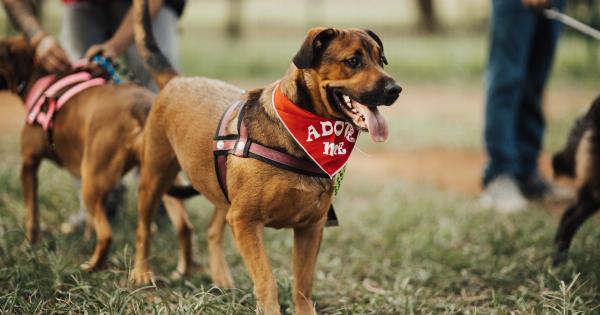As dog owners, we often find ourselves amazed by the complexity and depth of our beloved pet’s behavior. Dogs communicate with us in various ways, from their body language to their vocalizations.
However, deciphering and interpreting these actions can sometimes be challenging. How confident are you in understanding your dog’s actions? In this article, we will explore some common dog behaviors and help you become more confident in interpreting them.
The Language of Tail Wagging
A wagging tail is often seen as a sign of a happy dog. While this is generally true, it is essential to understand that tail wagging is not always an expression of joy.
Dogs wag their tails for different reasons, and the position and speed of the wag can convey specific messages.
A high, fast wag usually indicates excitement and happiness. On the other hand, a low, slow wag might suggest that the dog is cautious or unsure of the situation.
A tucked tail indicates fear or anxiety, while a stiff, upright tail can signal alertness or aggression. Understanding these subtle differences can help you gauge your dog’s emotional state better.
Decoding Facial Expressions
Just like humans, dogs also communicate a lot through their facial expressions. Learning to read these expressions can deepen your understanding of your canine companion.
For example, a relaxed dog will have a soft, relaxed face with slightly open eyes and a slightly open mouth. On the other hand, narrowed eyes, a wrinkled forehead, and showing front teeth can indicate aggression or stress.
The position of the ears is another essential aspect to consider. Upright and forward-facing ears indicate attentiveness or curiosity, while pinned back ears suggest fear or anxiety.
Paying attention to these small details can give you valuable insights into your dog’s current emotional state.
Interpreting Body Language
Body language is where dogs excel in communication. By understanding their body movements, you can gain a wealth of information about your dog’s intentions, emotions, and needs.
One common behavior is when a dog rolls onto their back, exposing their belly. While it may seem like an invitation for a belly rub, it can also be a sign of submission or even fear.
It is crucial to assess the overall context and other accompanying body signals to understand the message behind this action.
Another crucial body language cue is the dog’s stance. A confident dog will stand tall with their head held high, whereas an anxious or fearful dog may lower their body, hunching their shoulders.
Keep an eye out for any signs of tension or stiffness in their body, as these can signify stress or discomfort.
Communication Through Barks
Barking is a primary form of vocal communication for dogs. Understanding the different types of barks can help you comprehend what your dog is trying to communicate.
A sharp, short bark may indicate excitement or a warning to alert you about something. Continuous barking can be a sign of frustration, boredom, or the need for attention.
A prolonged, deep bark might suggest aggression or an attempt to protect their territory.
It is essential to pay attention to the pitch, duration, and intensity of the barking. By analyzing these factors, you can better understand why your dog is barking and respond accordingly.
Understanding Licking and Nipping
Licking is a common behavior among dogs, and it serves different purposes. While it can be a sign of affection or an attempt to establish social bonds, it can also be a way for dogs to communicate their needs or seek attention.
However, it is essential to distinguish between excessive licking and normal licking behavior. Excessive licking, particularly when focused on one specific area, can indicate discomfort, pain, or an underlying health issue.
If you notice such behavior, it is best to consult with your veterinarian.
Similarly, nipping or mouthing is a behavior often observed in puppies. It is a natural way for them to explore their environment and interact with their littermates.
However, it is crucial to discourage this behavior as they grow older to prevent any accidental harm. Understanding the context and teaching your dog appropriate behavior is key.
Signs of Stress and Anxiety
Dogs, like humans, can experience stress and anxiety. Recognizing the signs is essential in helping your furry friend find relief and comfort.
Some common signs of stress in dogs include excessive panting, drooling, yawning, pacing, or an inability to settle. They may also exhibit destructive behavior, such as chewing furniture or ripping up belongings.
These behaviors can indicate that your dog is experiencing anxiety and needs attention or assistance.
Creating a calming environment, providing mental and physical stimulation, and practicing positive reinforcement training can help reduce stress and anxiety in dogs.
Reading Signals During Playtime
Playtime is an important aspect of a dog’s life, providing mental and physical stimulation while reinforcing social bonds. However, even during play, it is crucial to decipher the signals to prevent any misunderstandings.
An enthusiastic, loose body posture, and inviting play bow indicate a dog’s interest in engaging in playful behavior. Rapid, exaggerated movements and high-pitched barks can also indicate excitement.
On the other hand, if one dog begins to show signs of stress or exhibits behaviors such as freezing, growling, or aggression, it is essential to intervene and redirect their attention to avoid potential conflicts.
Recognizing Fear Aggression
Fear aggression is a common issue faced by many dog owners. When a dog feels afraid or threatened, they may react aggressively as a defense mechanism.
Understanding the signs of fear aggression can help prevent escalation and improve your communication with your dog.
Some common signs of fear aggression include growling, bared teeth, raised hackles, and a tucked tail.
If your dog exhibits these behaviors, it is crucial to create a safe and supportive environment and consult with a professional dog trainer or behaviorist to address their fears and anxieties.
Meeting Strangers: Friendliness or Anxiety?
How your dog behaves around strangers can provide valuable insights into their temperament and comfort level with new people.
A dog who greets strangers with a relaxed, wagging tail and a calm demeanor is likely to be friendly and sociable.
However, if your dog shows signs of anxiety or fear, such as hiding, barking excessively, or cowering, it indicates that they feel uncomfortable or threatened.
It is crucial to respect your dog’s boundaries and gradually expose them to new experiences, providing positive reinforcement and rewards to help build trust and confidence.
Developing Your Confidence in Interpretation
Understanding your dog’s actions is an ongoing process that requires observation, patience, and a willingness to learn.
While this article provides a foundation, it is essential to remember that every dog is unique, and individual differences exist.
Investing time in building a strong bond with your dog through positive reinforcement training can enhance the mutual understanding between you and your furry companion.
Additionally, seeking advice and guidance from professional trainers or veterinarians can further boost your confidence and knowledge in interpreting your dog’s actions.
Conclusion
Interpreting your dog’s actions can be challenging, but with practice and knowledge, you can become more confident in understanding their needs, emotions, and intentions.
By paying attention to their tail wagging, facial expressions, body language, barks, and other behaviors, you’ll deepen your connection and enhance your ability to provide the care and support your dog deserves.






























